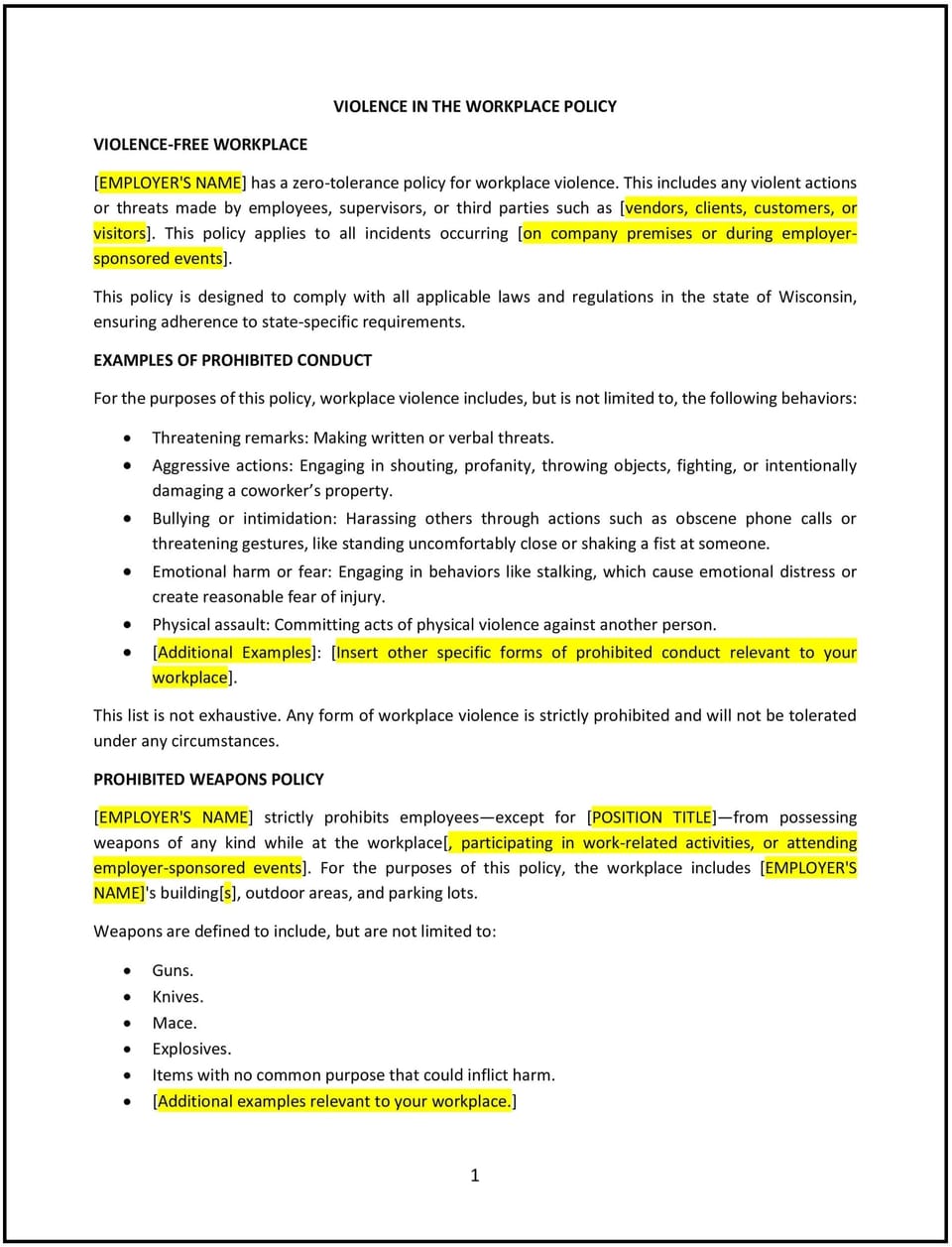Violence in the workplace policy (Wisconsin): Free template

Violence in the workplace policy (Wisconsin)
In Wisconsin, a violence in the workplace policy establishes clear guidelines to prevent and address workplace violence. This policy promotes employee safety, outlines acceptable behavior, and provides procedures for reporting and responding to incidents. By adopting this policy, businesses can foster a secure and respectful work environment while complying with Wisconsin state laws.
The policy defines workplace violence, describes preventive measures, and establishes protocols for handling threats or incidents effectively.
How to use this violence in the workplace policy (Wisconsin)
- Define workplace violence: Clearly outline what constitutes workplace violence, including physical harm, verbal threats, harassment, or any behavior that creates a hostile work environment.
- Establish reporting procedures: Provide employees with a confidential and straightforward process for reporting incidents of workplace violence.
- Outline response protocols: Detail the steps for investigating and addressing reported incidents, ensuring swift and appropriate action.
- Promote prevention: Encourage training and awareness programs to help employees identify and prevent workplace violence.
- Support compliance: Align the policy with Wisconsin state laws and federal regulations to ensure legal adherence and promote a culture of safety.
Benefits of using a violence in the workplace policy (Wisconsin)
- Enhances safety: Protects employees by providing clear procedures for preventing and addressing workplace violence.
- Supports compliance: Ensures alignment with Wisconsin state laws and federal workplace safety standards, such as those outlined by OSHA.
- Improves morale: Fosters a sense of security and trust among employees by demonstrating the company’s commitment to their well-being.
- Reduces liability: Minimizes legal risks associated with workplace violence by addressing issues proactively and transparently.
- Encourages accountability: Sets clear expectations for behavior and establishes consequences for policy violations.
Tips for using a violence in the workplace policy (Wisconsin)
- Train employees: Provide regular training to help employees recognize warning signs of violence and understand reporting procedures.
- Establish a zero-tolerance stance: Communicate the company’s zero-tolerance policy for workplace violence to reinforce expectations for behavior.
- Maintain confidentiality: Ensure that all reports of workplace violence are handled discreetly to protect the privacy of those involved.
- Review security measures: Regularly assess workplace safety protocols, such as access control and emergency response plans, to mitigate risks.
- Update periodically: Revise the policy to reflect changes in Wisconsin laws, industry standards, or workplace needs.
Q: What behaviors are considered workplace violence under this policy?
A: Workplace violence includes physical attacks, verbal threats, intimidation, harassment, or any behavior that causes harm or fear in the workplace.
Q: How can employees report incidents of workplace violence?
A: Employees can report incidents confidentially to their supervisor, HR, or a designated company representative, as outlined in the policy.
Q: What happens after a workplace violence report is filed?
A: The company will investigate the incident promptly, ensure the safety of all employees, and take appropriate actions, which may include disciplinary measures or involving law enforcement.
Q: How does this policy comply with Wisconsin laws?
A: This policy aligns with Wisconsin workplace safety laws and OSHA guidelines, promoting compliance and promoting a secure work environment.
Q: Are there preventive measures included in this policy?
A: Yes, the policy includes preventive measures such as employee training, clear communication of behavioral expectations, and regular safety assessments.
This article contains general legal information and does not contain legal advice. Cobrief is not a law firm or a substitute for an attorney or law firm. The law is complex and changes often. For legal advice, please ask a lawyer.


